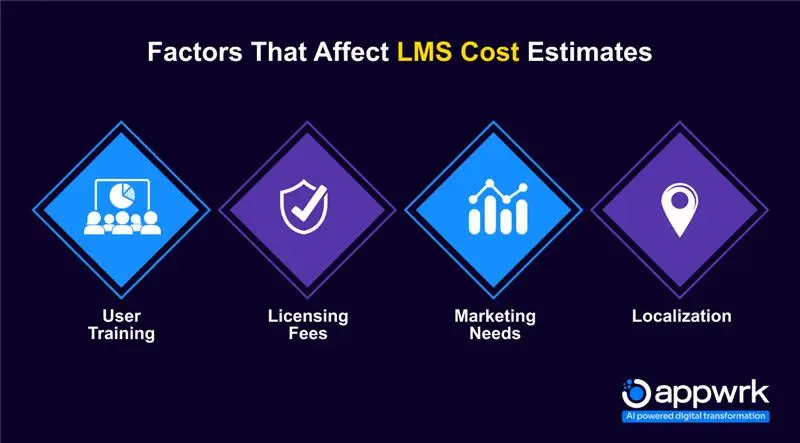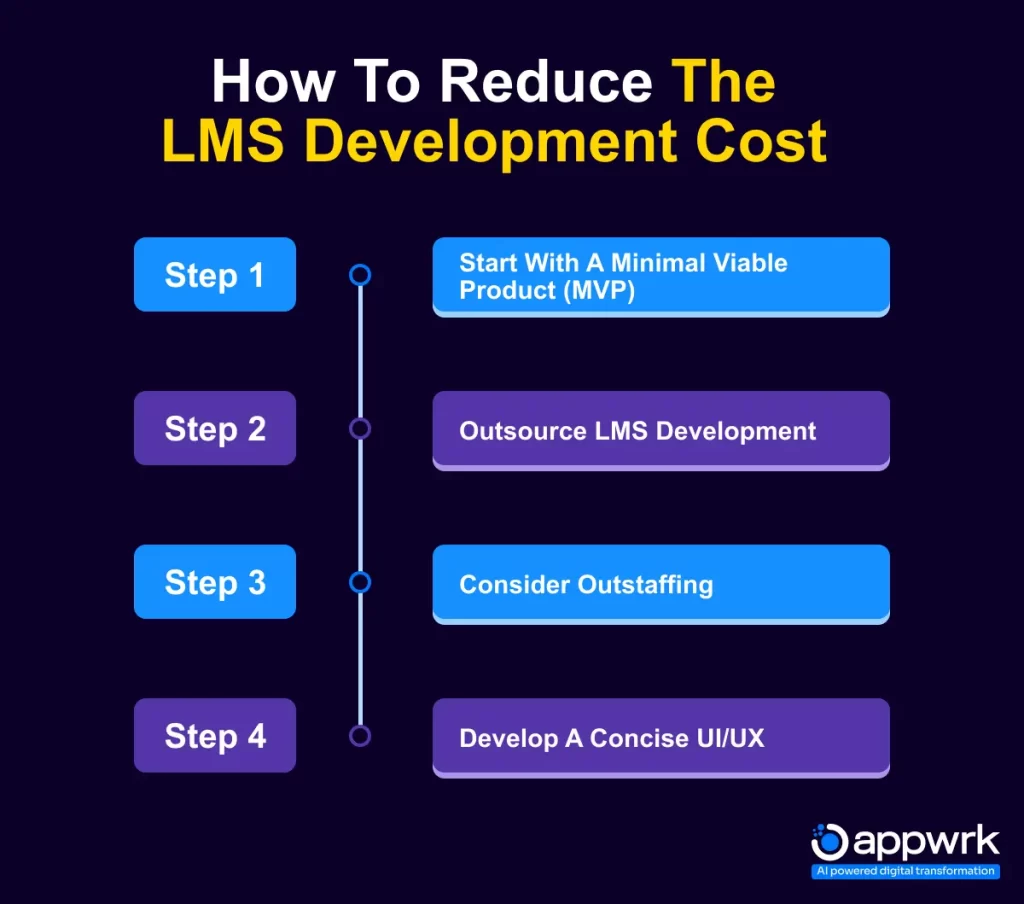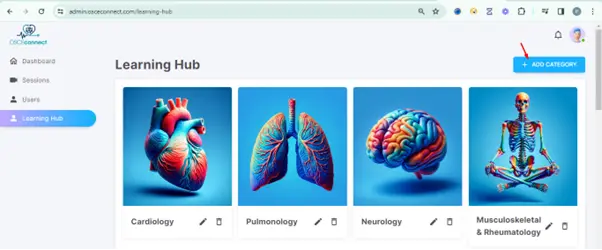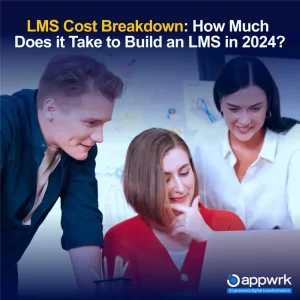How much does it cost to build a learning management system?
Whether you want to train new hires, upskill a group of people in the same role, or track a top performer’s career progression, a robust LMS can streamline the process and provide personalized learning experiences. Short for learning management systems, LMS is a software application that companies, businesses, and organizations use to create, organize, deliver, and analyze training for their learners. Not only does an LMS cost much less than manually training employees and play an essential role in organizing, delivering, and measuring your onboarding processes, but it can also enhance results, improve engagement, and reduce a great amount of stress for both the new hires and training staff. Additionally, understanding the LMS setup pricing is crucial for businesses to budget effectively and choose the right development process to develop a custom learning management system that aligns with your requirements.
According to MarketsandMarkets, the global LMS market is expected to grow from $ 22.1 billion in 2023 to $51.9 billion by 2027 at a CAGR of 18.6%.
Beyond enhancing corporate training, Learning Management Systems (LMS) deliver tangible business results, with organizations reporting a 42% boost in revenue after implementing these systems. LMS platforms empower teams to streamline training processes, track progress in real time, and create personalized learning experiences that drive engagement and productivity.
However, achieving these results requires more than adopting an off-the-shelf solution. Besides, many business owners get confused and ask themselves, “How much does it cost to build an LMS?” When it comes to developing an LMS, the accurate learning management system pricing will depend on every single detail, from the set of necessary functions and a visual depiction of the platform to the number as well as the seniority of experts involved or the desired timeline for the platform launch.
Let’s get into the nitty-gritty of the cost of learning management system development.
Table of contents
- What is the cost of learning management system development?
- LMS Development Cost Breakdown
- LMS Cost by the Type of the Solution
- Factors that Affect LMS Cost Estimates
- Steps to Reduce LMS Cost
- Time Needed to Develop a Learning Management System
- Our Learning Management System Development Case Study
- Consider APPWRK as a Trusted Partner for LMS Development
- Consider APPWRK as a Trusted Partner for LMS Development
- How long does it take to develop an LMS?
- Why are LMS so expensive?
- Do LMS companies license the content or build it themselves?
- How do you find out custom LMS cost estimates?
- How much does it cost to create a learning module?
- What factors should I consider when budgeting for LMS development?
What is the cost of learning management system development?
When it comes to developing an LMS, understanding the learning management system cost associated with the development of a learning management system (LMS) is essential to creating a realistic budget. These costs extend beyond the initial development and include factors like technology, marketing, and ongoing maintenance. By analyzing these cost components, you will be better equipped to allocate resources and avoid unexpected expenses.
Let’s dive into the primary factors that contribute to LMS development costs in detail.
Core Development costs
The development stage is the backbone of any LMS project. This involves coding, testing, and implementing the features that make the system functional and user-friendly. These functionalities influence the overall LMS cost. Here are the key costs associated with LMS development:
Technology costs
Choosing the right technology can be a game-changer for your LMS project. It involves carefully selecting a tech stack, tools, and frameworks crucial for your project. This phase includes the costs of obtaining licenses for these tools, investing in servers or cloud hosting services, implementing database and software management systems, and integrating third-party APIs to enhance your LMS’s functionality.
Infrastructure costs
A seamless learning experience demands a reliable infrastructure. This includes setting up hosting environments and configuring data storage systems to handle high data volume and traffic. Additionally, expenses related to network security and ongoing monitoring also add up to the infrastructure costs.
Labor costs
Building a robust Learning Management system requires a skilled team of developers, UI/UX designers, testers, and project managers. However, the costs of hiring these professionals can vary significantly depending on your approach—whether you outsource the work to a development firm or hire an in-house team of developers.
Choosing in-house development entails recurring expenses such as salaries, employee benefits, recruitment costs, and training for new hires. While this approach provides direct control over the project, it can greatly increase your budget.
On the other hand, outsourcing offers a more cost-efficient approach. By partnering with an external team, you only pay the fees outlined in the contract, avoiding overhead costs like benefits or long-term commitments. This approach is ideal for organizations seeking high-quality development without the financial burden of maintaining an in-house team
Maintenance costs
After launch, ongoing maintenance ensures that your LMS keeps running smoothly. This involves tasks like bug fixes, system updates, security patches, and performance monitoring to make sure that your platform remains efficient, secure, and aligned with user expectations.
Additional Costs in LMS Development
In addition to the primary expenses, there are some extra costs you need to consider when developing an LMS. The overall learning management system price will also be influenced by factors such as ongoing maintenance, third-party integrations, and scalability requirements, making it essential to plan your budget accordingly.
Training Cost
It goes without saying that you need to train admins as well as end users to utilize LMS. For training, you need to cover the costs of creating user guides, manuals, and training materials. This enables users to navigate the platform with ease, which is crucial for LMS’ success.
Content Creation and Curation Costs
One of the biggest investments while developing an LMS is creating quality eLearning content to engage users. This includes developing interactive courses, videos, quizzes, and modules. Whether you create content in-house or hire external creators, you should allocate a sufficient budget for content creation and curation.
User Support and Customer Service Costs
Providing effective customer support, such as ticket systems or live chat, is essential for ensuring a positive user experience. This includes managing user queries, troubleshooting technical issues, and providing ongoing assistance. A well-structured support system boosts user satisfaction and retention, but it also adds to the cost of LMS development.
Marketing Costs
To successfully launch and promote your LMS, you need a strong marketing strategy. Marketing costs typically involve running digital campaigns, creating advertisements, and building partnerships to reach your target audience. Effective marketing efforts can boost your visibility and drive the adoption of LMS.
Licensing Costs
If your LMS incorporates third-party software or libraries, you may have to pay the licensing fees. These costs depend on the tools and services integrated into your system; make sure to include these costs in the final LMS cost.
Also read: Craft CMS vs WordPress: Which will shine in 2024?

LMS Development Cost Breakdown
To effectively budget for your LMS project, it’s important to understand the different components that make up the total cost. Below is the breakdown of the average price range for key aspects of LMS development, which will help you estimate your total project cost.
| Cost Category | Average LMS Development Price Range |
| Technology Costs | $2,000-$10,000 |
| Infrastructure Costs | $1500-$5000 |
| Labor Costs | $20,000-$300,000 |
| Maintenance Costs | $5,000-$50,000 per year |
| Training Costs | $2000-$10,000 |
| Marketing Costs | $5,000-$20,000 |
| Licensing Costs | $2,000-$10,000 |

LMS Cost by the Type of the Solution
Deciding on the type of Learning Management System (LMS) is a crucial decision that directly impacts your LMS price and the success of your learning initiatives. Here are the three main types of LMS software and their price estimates, helping you choose the best option based on your budget and training needs:
Custom LMS
As the name suggests, a Custom LMS refers to creating a customized Learning Management System from scratch. In this type of development approach, the LMS is tailored to your organization’s specific needs, offering flexibility and control over features, design, and integrations. Custom solutions are built to grow with your organization, accommodating increased users, new content, or expanded functionalities over time.
While a custom LMS involves higher upfront costs—ranging from $75,000 to $500,000 or more—it offers a long-term return on investment by aligning perfectly with your needs and reducing reliance on third-party tools.
Ready-made LMS
For organizations seeking a fast and cost-effective way to implement a learning platform, a ready-made LMS stands out as an ideal choice. A ready-made LMS offers a pre-designed solution that can be deployed within days or weeks without compromising functionality. Additionally, ready-made systems come with lower initial costs, as the core platform has already been developed and tested by multiple users to ensure stability and minimize bugs.
The ready-made LMS pricing typically ranges from $15,000 to $100,000, depending on the platform, along with potential customization costs for additional features or integrations.
SaaS-based LMS
Software-as-a-Service (SaaS) LMS offers cloud-based learning management with a subscription-based pricing model. It offers unmatched flexibility and eliminates the burden of managing hosting, updates, and infrastructure. This makes it a popular choice for organizations looking for a scalable, low-maintenance platform with consistent access to the latest features and improvements.
The cost of a SaaS-based LMS depends on various factors such as the number of users, chosen feature packages, and any additional customization or branding requirements. Pricing typically ranges from $2000 to $10,000 annually for small and medium-sized businesses and $50,000 to $200,000 for large enterprises.
Factors that Affect LMS Cost Estimates

Developing an LMS involves more than just building a basic application—it requires careful planning to account for various factors that shape the overall cost. From ensuring seamless user adoption to tailoring the system for a global audience, these elements significantly impact your budget. Let’s explore the critical components you need to consider for an accurate LMS cost estimate:
- User Training: To ensure the success of your LMS software, you need to provide training and sessions for administrators and end-users so that LMS is used efficiently. While this adds to the overall LMS costs, it is a significant investment for long-term success.
- Licensing Fees: Integrating advanced tools and services often comes with associated licensing fees, especially in the case of ready-made and Saas-based LMS. These recurring or one-time charges can significantly affect your budget, depending on the number and type of tools integrated into your custom LMS.
- Marketing Needs: To maximize the reach of your LMS and drive adoption, you will need a robust marketing strategy. However, implementing extensive campaigns—whether through digital ads, content creation, or partnerships—can increase expenses.
- Localization: If your LMS caters to a global audience, offering localized content through translation and regional adaptations is crucial for inclusivity. This not only improves accessibility and user engagement but also leads to additional costs to the project.
Steps to Reduce LMS Cost

Let’s face it, building a learning management system can cost a fortune. Aside from the coding itself and the team involved in the process, building an LMS brings a number of additional items that can affect the development budget. If you’re looking to build an effective LMS without breaking the bank, there are multiple strategies you can implement to reduce costs while still delivering a high-quality solution. Here’s how you can cut down on expenses while maintaining a robust and functional platform:
Start with a Minimal Viable Product (MVP)
Creating a minimum viable product with only one core functionality allows you to test your LMS in the real world with a group of users. This approach will allow you to launch your LMS quickly, gather user feedback, fix issues, and refine the platform before expanding. It minimizes upfront costs and avoids overloading with excess functionality.
Outsource LMS Development
Without a doubt, outsourcing the development of your LMS can significantly reduce labor costs, especially if you are looking to reduce labor expenses without compromising the quality. You can hire experienced developers from cost-effective regions and develop a high-quality LMS. This approach will let you access top-tier talent without the hefty price tag.
Consider Out-staffing
If you require specific skills or expertise on a temporary basis, hiring remote, contract-based professionals is your best bet. It offers the flexibility to bring in highly-skilled developers when needed and cut down the costs associated with full-time employment. This will enable you to allocate resources efficiently and develop the LMS at a price that’ll fit right into your budget.
Developing a Concise UI/UX
Having a well-designed, user-friendly interface can reduce the need for user training and support, which in turn will help you save both time and costs. By creating a clean and intuitive UI/UX design, you can ensure that users can easily navigate the system without the need of extensive onboarding. A simplified LMS interface also cuts down on development time, which decreases initial costs while maintaining a scalable, efficient platform. Focusing on a clean design and ease of use can help boost user engagement and save money in the long term.
Also read: How Much Does It Cost To Hire App Developers?

Time Needed to Develop a Learning Management System
The timeline for Learning Management System development can vary depending on the complexity and scope. On average, developing a functional LMS can take 6 to 12 months, considering the design, development, testing, and deployment stages. However, this timeframe can be extended if the project involves advanced features, customized integrations, and multi-platform compatibility.
Several factors that impact the development timeline include:
- Feature Complexity: The addition of more advanced functionalities, such as gamification or AI-driven analytics, requires more time for development.
- Custom Development: Customizing the LMS to meet specific business needs, workflows, and user requirements often extends project timelines.
- UI/UX Design: Crafting a simple, intuitive user interface and ensuring a seamless user experience requires extensive planning, design, and testing.
- Integration Requirements: Incorporating third-party tools, APIs, or other software systems can increase both the time needed and the level of customization required.
- Quality Assurance & Testing: Thorough testing for bugs, performance, and security is crucial and time-consuming, particularly for complex systems.
- Multi-Platform Support: Ensuring compatibility across multiple devices, browsers, or operating systems needs additional time for testing and optimization.
Our Learning Management System Development Case Study
Over the years, Learning management systems have become indispensable tools for organizations seeking to effectively deliver and manage their learning and training programs. Seeing this incredible growth, OSCE Connect approached APPWRK to create a customized LMS.
APPWRK’s approach and solution
OSCE Connect’s goal was to create an intuitive platform tailored to the unique needs of OSCE candidates, examiners, and observers. Our team of experts developed a custom LMS for dynamic material updates and implemented real-time interactive sessions that facilitated candidate-examiner engagement while maintaining observer restrictions. By addressing their unique challenges, we delivered a seamless, user-focused platform that enhances student performance and transforms OSCE preparation.
Business Impact
The main goal of OSCE Connect was to improve learners’ performance in the OSCE examination. APPWRK customized LMS as per the client’s requirements and added immersive and interactive features, including live sessions with examiners, and provided learners with real-time feedback and question clarification opportunities. As a result, students were able to refine their clinical skills, improve their communication abilities, and gain a deeper understanding of OSCE expectations.

Also Read: Which is Best CMS: Webflow or WordPress?
Consider APPWRK as a Trusted Partner for LMS Development

Are you looking to build a high-quality Learning Management System (LMS) to enhance your team’s skills and knowledge without spending a fortune? Look no further! At APPWRK, we specialize in crafting tailor-made custom LMS solutions that align with your organization’s goals and budget. With a dedicated team of seasoned developers and a proven track record of successful projects, we ensure your LMS not only meets your unique needs but also delivers long-term value.
How Much Does It Cost to Build an LMS? [Final Estimate]
Even though determining the exact cost of an LMS can be challenging as it depends on multiple factors, typically, the LMS development cost can range from $20,000-$200,000, depending on whether you choose to build a basic LMS or a fully customized solution with advanced features. Basic and straightforward LMS platforms fall on the lower end of the spectrum, while customized solutions with advanced features and scalability tend to be more expensive.
Whether you’re onboarding new employees or helping loyal staff with professional development, creating a learning management system is a significant investment that requires proper planning and budgeting. With a well-designed LMS, you can transform your organization’s training processes and drive growth. Choosing between custom LMS development or a ready-made solution is crucial to aligning the system with your specific goals and budget. By understanding the key factors that influence LMS pricing, you can make an informed decision.
Consider APPWRK as a Trusted Partner for LMS Development
Are you looking to build a high-quality Learning Management System (LMS) to enhance your team’s skills and knowledge without spending a fortune? Look no further! APPWRK IT Solutions, an app development and AI-driven digital transformation company specializes in crafting tailor-made custom LMS solutions that align with your organization’s goals and budget. With a dedicated team of seasoned developers and a proven track record of consistently successful projects, we ensure your LMS not only meets your unique needs but also delivers long-term value.
FAQs on LMS Development Cost
How long does it take to develop an LMS?
The development timeline for an LMS with basic features typically ranges from 6 to 12 months, While a more complex system could take 9 to 18 months or longer. The development timeline depends on a number of factors, such as the complexity of features, degree of customization, and integration of third-party tools. Extensive testing and iterative enhancements can potentially extend the timeline but ensure a high-quality, user-friendly end product.
Why are LMS so expensive?
The cost of LMS development is largely determined by various factors like:
- Custom functionality
- Advanced integrations
- Extensive content creation
- Ongoing maintenance.
Do LMS companies license the content or build it themselves?
LMS companies can approach content creation in different ways. Some companies create content in-house tailored to specific industries or client needs. Whereas others license content from third-party providers, offering a curated library of pre-built courses on various topics. This approach is cost-effective and allows the LMS to provide a wide range of ready-to-use material quickly.
In many cases, LMS companies offer a hybrid approach, combining licensed content with custom-built materials, giving users the best of both worlds.
How do you find out custom LMS cost estimates?
Every LMS project is different, and understanding the unique requirements is key to estimating LMS costs accurately. To accurately estimate the cost of building a custom LMS, consider the following factors:
- Define LMS Feature Requirements
- Determine the Scale and User Volume
- Assess Technology and Infrastructure Needs
- Plan for Design, User Interface, and Experience
- Consider Ongoing Maintenance and Updates
- Include Training, Support, and Documentation Costs
How much does it cost to create a learning module?
The cost of developing a learning module can vary significantly, ranging from $1,000 to $10,000, based on factors like the type of content, design complexity, and production quality.
What factors should I consider when budgeting for LMS development?
When budgeting for LMS development, key factors influencing LMS cost include user training, infrastructure setup, marketing efforts, and ongoing maintenance costs. User training ensures effective utilization, while infrastructure setup ensures reliable performance. Marketing efforts help drive adoption, and ongoing maintenance is essential for long-term success. Each of these components adds to the overall LMS cost, so understanding them helps in creating a more realistic budget that supports sustainable growth and maximizes ROI for your custom LMS.
What factors influence LMS setup pricing?
Understanding the price for developing the learning management system from scratch helps you reduce and streamline the development process. LMS setup pricing depends on various factors that are listed below:
- Number of users
- Customization requirements
- Integration with existing systems
- Hosting preferences (cloud-based or on-premise)
- Additional features like analytics, gamification
- Mobile accessibility
About The Author


 Free Quote
Free Quote
















































